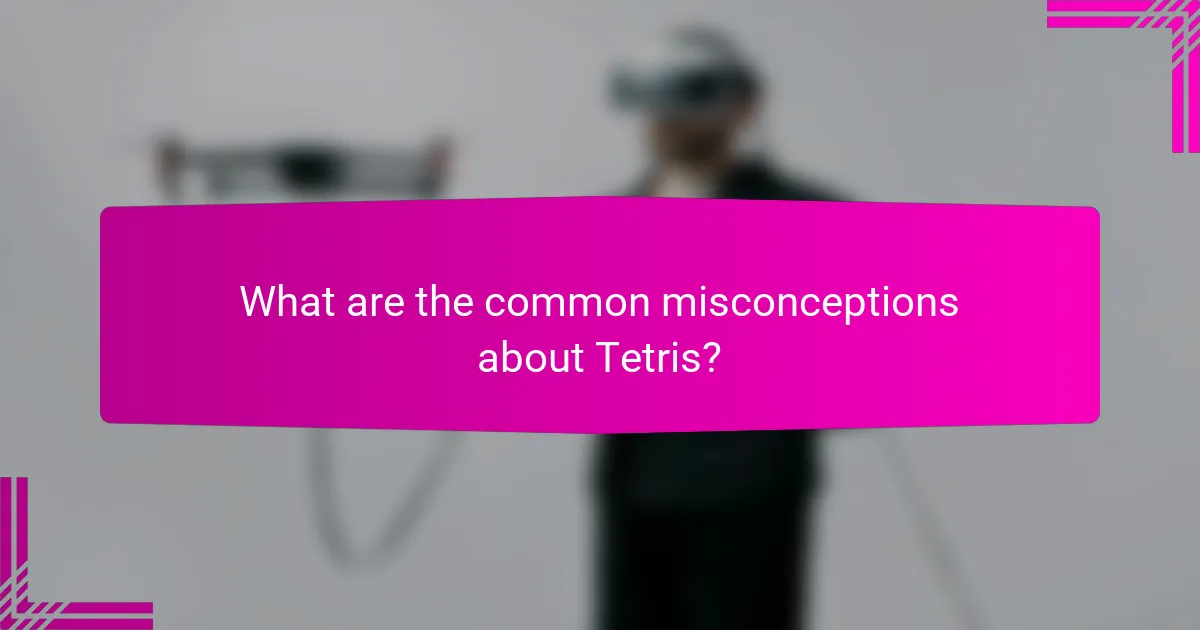Tetris offers numerous cognitive benefits and challenges players with its strategic gameplay. This article explores Tetris’s history from its 1984 inception, examines its core gameplay mechanics, and highlights its profound cultural impact. We will also discuss various game versions, address common misconceptions, and provide tips for maximizing the Tetris experience.

How did Tetris evolve from its inception to modern adaptations?
Tetris has evolved significantly since its creation in 1984, adapting to technological advancements and cultural shifts. Initially developed by Alexey Pajitnov, it featured simple gameplay mechanics focused on arranging falling blocks. As gaming technology advanced, Tetris transitioned from arcade machines to home consoles and mobile devices, enhancing accessibility.
The introduction of multiplayer modes and various game formats, such as Tetris 99, showcased its adaptability and competitive nature. The game’s cultural impact is profound, influencing game design and becoming a symbol of gaming itself. Unique attributes, like its addictive gameplay and iconic music, have maintained its relevance across generations.
What were the key milestones in Tetris development?
The key milestones in Tetris development include its creation in 1984, the introduction of the Game Boy version in 1989, and its expansion into various platforms over the years. Alexey Pajitnov developed Tetris in the Soviet Union, leading to its widespread popularity. The game’s simple, addictive mechanics contributed to its cultural impact, establishing it as a classic in video game history. In 2005, Tetris was inducted into the World Video Game Hall of Fame, highlighting its lasting legacy.
Which platforms have featured Tetris throughout the years?
Tetris has been featured on numerous platforms since its creation in 1984, including consoles, handheld devices, and mobile phones. Key platforms include the Game Boy, NES, PlayStation, Xbox, and various smartphones. Each adaptation has introduced unique gameplay mechanics and graphics, contributing to Tetris’s lasting popularity. The game’s availability on diverse platforms has played a significant role in its cultural impact and recognition worldwide.
How have graphics and gameplay mechanics changed over time?
Graphics and gameplay mechanics in Tetris have evolved significantly since its inception in 1984. Initially, Tetris featured simple pixelated graphics and straightforward mechanics focused on block placement. Over time, advancements in technology allowed for enhanced graphics, introducing vibrant colors and animated backgrounds.
Gameplay mechanics have also transformed, incorporating new modes and features. For example, multiplayer options emerged, allowing players to compete against each other, adding a social dimension to the game. Unique attributes, such as the introduction of T-spins and combos, have deepened strategic gameplay.
Additionally, mobile adaptations have led to touch controls, making Tetris more accessible. Rare attributes, like themed versions and crossover events, have further diversified the Tetris experience, ensuring its cultural impact endures across generations.

What are the fundamental gameplay mechanics of Tetris?
Tetris gameplay mechanics center around arranging falling blocks called Tetriminos to clear lines. Players rotate and position these shapes to create complete horizontal lines, which then disappear, earning points. Key mechanics include gravity, collision detection, and line clearing. Unique attributes involve the T-spin maneuver and combos, which enhance scoring potential. The game’s simplicity belies its strategic depth, making it a cultural icon.
How does the scoring system work in Tetris?
In Tetris, the scoring system rewards players for clearing lines and completing specific actions. Players earn points by clearing single lines, double lines, triple lines, or a Tetris (four lines at once). The more lines cleared simultaneously, the higher the score multiplier applied. Additionally, players receive bonus points for back-to-back Tetrises and for completing levels with a higher speed. The scoring system encourages strategic placement of blocks to maximize line clears and achieve higher scores.
What are the different game modes available in Tetris?
Tetris features several game modes, each offering unique gameplay experiences. The primary modes include Classic, Marathon, Sprint, and Battle Royale.
Classic mode is the traditional format where players clear lines to score points. Marathon mode challenges players to clear as many lines as possible until they reach a predetermined level. Sprint mode focuses on clearing a specific number of lines within a time limit. Battle Royale mode allows players to compete against others, sending garbage blocks to opponents as they clear lines.
Each mode emphasizes different aspects of strategy and skill, catering to various player preferences.
Which strategies enhance performance in Tetris?
To enhance performance in Tetris, players should focus on strategies like maintaining a clean stack, utilizing T-spins, and mastering piece rotation. These techniques improve efficiency and scoring potential.
Maintaining a clean stack prevents gaps, allowing for easier placements of incoming pieces. T-spins, which involve rotating T-shaped blocks into tight spaces, can yield higher points and clear multiple lines. Additionally, mastering piece rotation can help adapt to various scenarios, ensuring optimal placements.
Players can also practice speed and decision-making under pressure to improve their overall gameplay. Regular practice with specific strategies can lead to noticeable performance enhancements.

Why is Tetris considered a cultural phenomenon?
Tetris is considered a cultural phenomenon due to its widespread influence on gaming and popular culture. Since its release in 1984, Tetris has shaped game design, introduced innovative gameplay mechanics, and created a lasting legacy in various media. Its simple yet addictive nature appeals to a broad audience, making it a staple in both casual and competitive gaming. The game’s iconic status is reflected in its presence in art, music, and even psychology, highlighting its impact beyond entertainment. Tetris has fostered community and competition through tournaments and online platforms, further solidifying its cultural relevance.
How has Tetris influenced gaming culture and design?
Tetris has profoundly influenced gaming culture and design by introducing innovative mechanics and fostering a competitive spirit. Its simple yet addictive gameplay set a standard for puzzle games. The game’s iconic status has led to numerous adaptations and inspired countless developers. Tetris popularized concepts like score-based competition and level progression, impacting game design across genres. Its cultural significance is evident in its presence in art, music, and even psychology, showcasing the game’s lasting legacy in both entertainment and academic studies.
What role has Tetris played in competitive gaming?
Tetris has significantly shaped competitive gaming by establishing foundational mechanics and fostering a global community. Its introduction of skill-based play and strategy has influenced numerous tournaments and players. The game’s mechanics, such as T-spins and combos, allow for advanced strategies, making competition engaging. Tetris has also inspired various adaptations and spin-offs, further solidifying its role in the competitive landscape. As a result, it remains a benchmark for skill and strategy in gaming.
How has Tetris been represented in popular media?
Tetris has been represented in popular media through various adaptations, including films, television shows, and merchandise. The game’s iconic status has inspired documentaries like “Tetris: From Russia with Love,” which explores its origins and cultural significance. Additionally, Tetris has appeared in animated series, video game references in popular culture, and even music, with remixes of its theme. The unique gameplay mechanics and aesthetic have made it a lasting symbol of gaming history, influencing countless other games and media representations.

What are the psychological effects of playing Tetris?
Playing Tetris can lead to positive psychological effects, including improved cognitive skills and reduced stress. Research indicates that Tetris enhances spatial awareness and problem-solving abilities. Additionally, players often experience a phenomenon known as the “Tetris Effect,” where they visualize game patterns in real life, promoting creativity. Engaging with Tetris can also serve as a form of distraction, helping to alleviate symptoms of anxiety and depression. Overall, Tetris offers both mental stimulation and emotional relief.
How does Tetris impact cognitive skills and problem-solving?
Tetris enhances cognitive skills and problem-solving by improving spatial awareness, memory, and strategic thinking. Research shows that regular gameplay can lead to increased brain efficiency and better decision-making abilities. Players develop quicker reaction times and improved multitasking skills, essential for effective problem-solving in various contexts. Additionally, Tetris engages players in pattern recognition, fostering creativity and adaptability in tackling challenges.
What are the benefits of playing Tetris for mental health?
Playing Tetris can enhance mental health by improving cognitive skills, reducing stress, and increasing focus. The game requires quick thinking and spatial awareness, which stimulate brain activity. Research indicates that engaging with Tetris can lead to a decrease in intrusive thoughts and anxiety levels. Additionally, the immersive nature of the game promotes relaxation, contributing to overall emotional well-being.

Which unique attributes distinguish different versions of Tetris?
Different versions of Tetris are distinguished by unique attributes such as gameplay mechanics, graphics style, and multiplayer options. For instance, Tetris 99 introduces a battle royale format, while Tetris Effect emphasizes immersive visuals and music integration. Classic versions focus on simple mechanics and 2D graphics. Variants like Tetris Blitz incorporate power-ups and time-limited challenges, showcasing diverse gameplay experiences. Each version tailors the core Tetris experience to different audiences, enhancing its cultural impact.
What are the notable variations of Tetris gameplay?
Tetris gameplay features several notable variations that enhance the classic experience. These include multiplayer modes such as Tetris 99, where players compete against each other, and cooperative modes like Tetris Effect, which emphasizes visual and auditory immersion.
Additionally, there are themed versions like Puyo Puyo Tetris, which combine Tetris with other puzzle mechanics. Speedrun modes challenge players to complete levels as quickly as possible, while custom rule sets allow for unique gameplay experiences, such as adjusting gravity or piece rotation.
Each variation offers distinct gameplay mechanics that cater to different player preferences and skill levels.
How do regional adaptations of Tetris differ?
Regional adaptations of Tetris differ primarily in gameplay mechanics, visual themes, and cultural references. For example, the music and graphics may reflect local traditions. In Japan, Tetris often features anime-inspired visuals, while Western versions may include pop culture elements. Unique adaptations can also introduce new game modes or rules, enhancing the experience. These variations highlight Tetris’s ability to resonate with diverse audiences while maintaining its core gameplay.

What are the common misconceptions about Tetris?
Many misconceptions exist about Tetris, often oversimplifying its impact and mechanics. One common belief is that Tetris is merely a mindless game, but it actually enhances cognitive skills like spatial awareness and problem-solving. Another misconception is that Tetris is only for casual players; in reality, it has a competitive scene with professional tournaments. Some think Tetris is outdated, yet it continues to evolve with new versions and adaptations. Lastly, many underestimate its cultural significance, as it has influenced various media and inspired countless games.
Why do some players struggle with Tetris despite its simplicity?
Some players struggle with Tetris due to its fast-paced nature and the need for spatial awareness. The game requires quick decision-making and adaptability, which can overwhelm new or casual players. Additionally, the pressure to maintain a high score adds to the challenge. Players may also face difficulty in visualizing how pieces fit together, impacting their overall performance. Mastery involves practice and understanding gameplay mechanics, which can take time to develop.
What are the myths surrounding Tetris and addiction?
Tetris does not inherently cause addiction, but its engaging gameplay can lead to excessive play. Common myths include the belief that Tetris is addictive in a clinical sense, that it negatively impacts mental health, and that it is solely a solitary experience. In reality, Tetris promotes cognitive skills and can be enjoyed socially. The game’s design encourages flow, which can be misinterpreted as addictive behavior. Understanding these myths helps clarify Tetris’s true cultural impact and its role in gaming history.

How can players maximize their Tetris experience?
To maximize the Tetris experience, players should focus on mastering gameplay mechanics, understanding strategies, and engaging with the community. Practicing regularly enhances skill and reflexes. Learning advanced techniques, such as T-spins and combos, can significantly improve scores.
Engaging with Tetris communities online provides tips and strategies from experienced players. Participating in competitions can also boost motivation and skill level. Additionally, customizing controls and settings based on personal preference can enhance comfort and performance.
What tips and strategies can improve Tetris skills?
To improve Tetris skills, practice regularly, learn advanced techniques, and analyze gameplay. Focus on mastering T-spins, line clears, and optimal piece placement. Additionally, watch skilled players to gain insights into strategies and decision-making. Finally, track your progress to identify areas for improvement.
Which resources are recommended for Tetris enthusiasts?
Tetris enthusiasts can explore a variety of resources to enhance their experience. Recommended options include official game websites, fan forums, strategy guides, and online communities. These platforms provide insights into gameplay mechanics, tips for improvement, and discussions on cultural impact. Additionally, streaming platforms feature gameplay videos that showcase competitive play and strategies.
